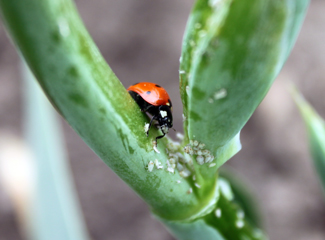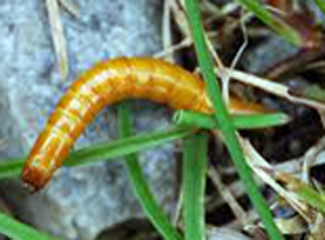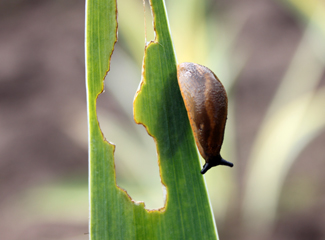Tall Bearded Iris Pests

Are there any "animals" that like to eat my iris?
Iris are vigorous and hardy plants and are not generally prone to disease so they require very little maintenance.
The following though is a list of possible problems your plants might face.
APHIDS:

Aphids suck the sap out of plants and can transfer diseases. This may cause your iris to become deformed or die.
The first—and often best—option to get rid of aphids is to just leave them alone. Birds love aphids. Also aphids lure in ladybugs, who along with their larvae, can eat several hundred each day. Growing plants that are especially attractive to aphids can actually help with a serious infestation.
Plants like nasturtiums, asters, mums, cosmos, hollyhocks, larkspur, tuberous begonias, verbena, dahlias, and zinnias are very attractive to aphids and are especially good for an organic control of these pests. Grow these plants away from your iris. They will act as a lure, keeping the aphids away and your iris aphid-free. You can also try planting garlic or onion plants nearby the infested plants. The smell of these plants drives the aphids away. You can plant garlic and onions in pots for mobile homemade aphid control.
Another option is to spray soapy water onto the plants using a spray bottle. The soapy water coats the insects and effectively smothers them. In order for a soap spray to work, it must come into contact with the aphids. So it is very important to spray the entire affected plant, including the tops and bottoms of its leaves. Thoroughly inspect the plant after a couple of days and use the soap spray again if necessary.
IRIS BORERS

Signs of Iris Borer:
The first signs of iris borer damage are difficult to recognize unless you know what to look for. Tunneling through the foliage that looks waterlogged is a sure sign of iris borers. If the tips of the foliage turn yellow, and then start to look dead, that's another sign. And, if the base of the stalk has become yellowish-brown and mushy, and has a sickly odor, they have gotten into the rhizome and rot has set in. If you are digging irises to divide or move them, you may notice holes in rhizomes as well.
Effect on Irises:
In some cases, the plant will, surprisingly, live on if rot hasn't set in. Most likely, it will bloom less, or not at all. In many cases, however, we aren't as lucky and the caterpillars cause so much damage that the rhizome rots completely.
Organic Control for Iris Borers:
Monitor your plants closely throughout April and May. If you begin to see signs of tunneling, prune off the affected foliage below where the damage occurs. The caterpillar, still quite small, will be trapped inside the section you've removed, and destroy. If you notice rot at the base of the stalk, dig up the rhizomes to inspect them. If you see tunneling into the rhizome, but are unsure whether or not the borer is still inside, soak the rhizome in a 9 part water to 1 part bleach solution. The borer will drown and you disinfect your iris at the same time. Inspect the rhizome. If the damage isn't too serious, cut away the damaged areas and let the cut dry for several hours before replanting.
Prevention:
The key here is cleanliness. If there is no leftover foliage in which the eggs can overwinter, there will likely be no caterpillars to contend with. Always remove old stalks and foliage after the plants are hit with a frost.
SNAILS & SLUGS

Schnecken bevorzugen insbesondere junge oder frisch ausgetriebene Pflanzen und verursachen Löcher (auch in der Blattmitte) und zerfressene Blätter bis hin zum Kahlschlag. Schneckenbekämpfung kann auf unterschiedliche Art und Weise erfolgen; z.B. ganz einfach mit einem alten Plastikblumentopf, dessen Boden man abschneidet und dann vorsichtig über die Iris stülpt (min. 10cm im Boden und 20cm in die Höhe) oder mit einem Schneckenzaum, der aber nicht günstig zu kaufen ist. Die beliebtestes Methode ist das Schneckenkorn; es gibt aber mittlerweile auch ökologisch, nachhaltige Produkte auf dem Markt.
Go to Iris4u Catalog